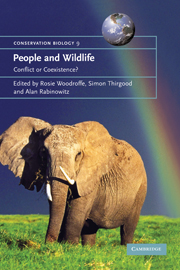Book contents
- Frontmatter
- Contents
- List of contributors
- Foreword
- Acknowledgements
- 1 The impact of human–wildlife conflict on natural systems
- 2 The impact of human–wildlife conflict on human lives and livelihoods
- 3 Characterization and prevention of attacks on humans
- 4 Non-lethal techniques for reducing depredation
- 5 Techniques to reduce crop loss: human and technical dimensions in Africa
- 6 Evaluating lethal control in the management of human–wildlife conflict
- 7 Bearing the costs of human–wildlife conflict: the challenges of compensation schemes
- 8 Increasing the value of wildlife through non-consumptive use? Deconstructing the myths of ecotourism and community-based tourism in the tropics
- 9 Does extractive use provide opportunities to offset conflicts between people and wildlife?
- 10 Zoning as a means of mitigating conflicts with large carnivores: principles and reality
- 11 From conflict to coexistence: a case study of geese and agriculture in Scotland
- 12 Hen harriers and red grouse: the ecology of a conflict
- 13 Understanding and resolving the black-tailed prairie dog conservation challenge
- 14 People and elephants in the Shimba Hills, Kenya
- 15 Safari hunting and conservation on communal land in southern Africa
- 16 Socio-ecological factors shaping local support for wildlife: crop-raiding by elephants and other wildlife in Africa
- 17 Jaguars and livestock: living with the world's third largest cat
- 18 People and predators in Laikipia District, Kenya
- 19 Searching for the coexistence recipe: a case study of conflicts between people and tigers in the Russian Far East
- 20 A tale of two countries: large carnivore depredation and compensation schemes in Sweden and Norway
- 21 Managing wolf–human conflict in the northwestern United States
- 22 Policies for reducing human–wildlife conflict: a Kenya case study
- 23 An ecology-based policy framework for human–tiger coexistence in India
- 24 The future of coexistence: resolving human–wildlife conflicts in a changing world
- References
- Index
21 - Managing wolf–human conflict in the northwestern United States
Published online by Cambridge University Press: 23 November 2009
- Frontmatter
- Contents
- List of contributors
- Foreword
- Acknowledgements
- 1 The impact of human–wildlife conflict on natural systems
- 2 The impact of human–wildlife conflict on human lives and livelihoods
- 3 Characterization and prevention of attacks on humans
- 4 Non-lethal techniques for reducing depredation
- 5 Techniques to reduce crop loss: human and technical dimensions in Africa
- 6 Evaluating lethal control in the management of human–wildlife conflict
- 7 Bearing the costs of human–wildlife conflict: the challenges of compensation schemes
- 8 Increasing the value of wildlife through non-consumptive use? Deconstructing the myths of ecotourism and community-based tourism in the tropics
- 9 Does extractive use provide opportunities to offset conflicts between people and wildlife?
- 10 Zoning as a means of mitigating conflicts with large carnivores: principles and reality
- 11 From conflict to coexistence: a case study of geese and agriculture in Scotland
- 12 Hen harriers and red grouse: the ecology of a conflict
- 13 Understanding and resolving the black-tailed prairie dog conservation challenge
- 14 People and elephants in the Shimba Hills, Kenya
- 15 Safari hunting and conservation on communal land in southern Africa
- 16 Socio-ecological factors shaping local support for wildlife: crop-raiding by elephants and other wildlife in Africa
- 17 Jaguars and livestock: living with the world's third largest cat
- 18 People and predators in Laikipia District, Kenya
- 19 Searching for the coexistence recipe: a case study of conflicts between people and tigers in the Russian Far East
- 20 A tale of two countries: large carnivore depredation and compensation schemes in Sweden and Norway
- 21 Managing wolf–human conflict in the northwestern United States
- 22 Policies for reducing human–wildlife conflict: a Kenya case study
- 23 An ecology-based policy framework for human–tiger coexistence in India
- 24 The future of coexistence: resolving human–wildlife conflicts in a changing world
- References
- Index
Summary
INTRODUCTION
The grey wolf (Canis lupus) is the most widely distributed large carnivore in the northern hemisphere (Nowak 1995) and has a reputation for killing livestock and competing with human hunters for wild ungulates (Young 1944; Fritts et al. 2003). Wolves rarely threaten human safety, but many people still fear them. In the western USA, widespread extirpation of ungulates by colonizing settlers, wolf depredation on livestock and negative public attitudes towards wolves resulted in extirpation of wolf populations by 1930 (Mech 1970; McIntyre 1995). By 1970, mule deer (Odocoileus hemionus), white-tailed deer (O. virginianus), elk (Cervus elaphus), moose (Alces alces) and bighorn sheep (Ovis canadensis) populations had been restored throughout the western USA while bison (Bison bison) were recovered only in Yellowstone National Park. However, grey wolves were still persecuted. In 1974, grey wolves were protected and managed by the US Fish and Wildlife Service under the federal Endangered Species Act of 1973.
In 1986, the first recorded den in the western USA in over 50 years was established in Glacier National Park by wolves that naturally dispersed from Canada (Ream et al. 1989). Restoration of wolves in that region emphasized legal protection and building local public tolerance. Wolves from Canada were reintroduced to central Idaho and Yellowstone National Park in 1995 and 1996 to accelerate restoration (Bangs and Fritts 1996; Fritts et al. 1997). The Northern Rocky Mountains wolf population grew from 10 wolves in 1987 to 663 wolves by 2003 (US Fish and Wildlife Service et al. 2003) (Fig. 21.1, Table 21.1).
- Type
- Chapter
- Information
- People and Wildlife, Conflict or Co-existence? , pp. 340 - 356Publisher: Cambridge University PressPrint publication year: 2005
- 23
- Cited by

